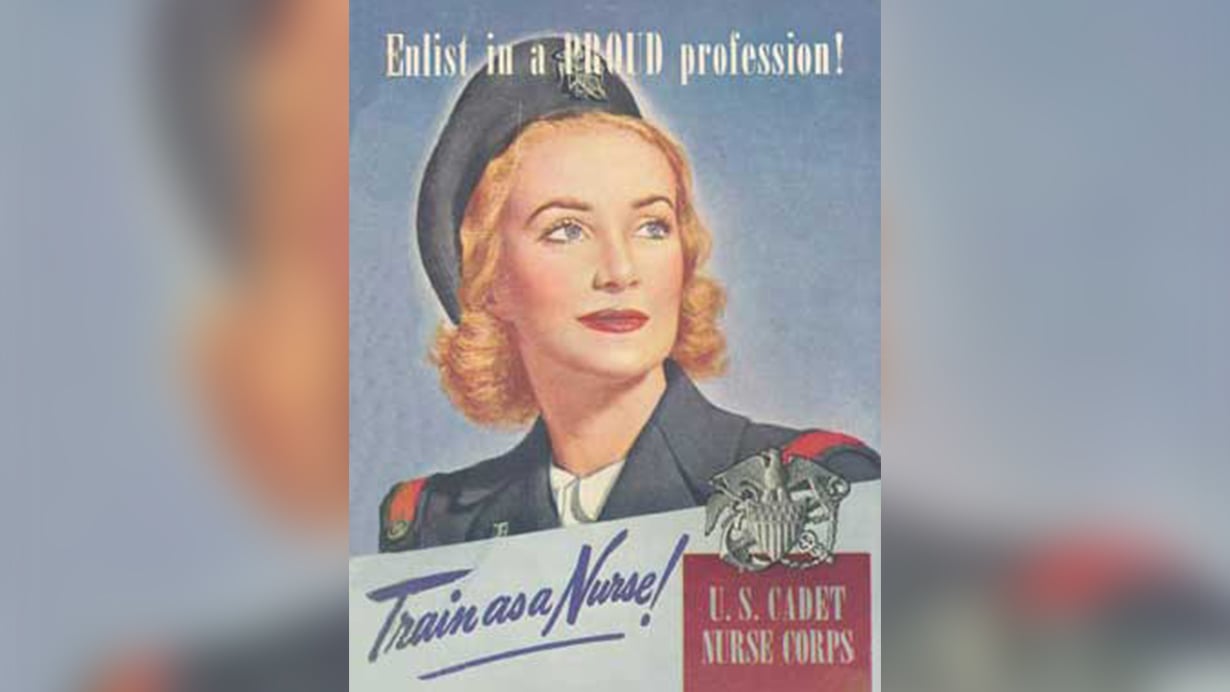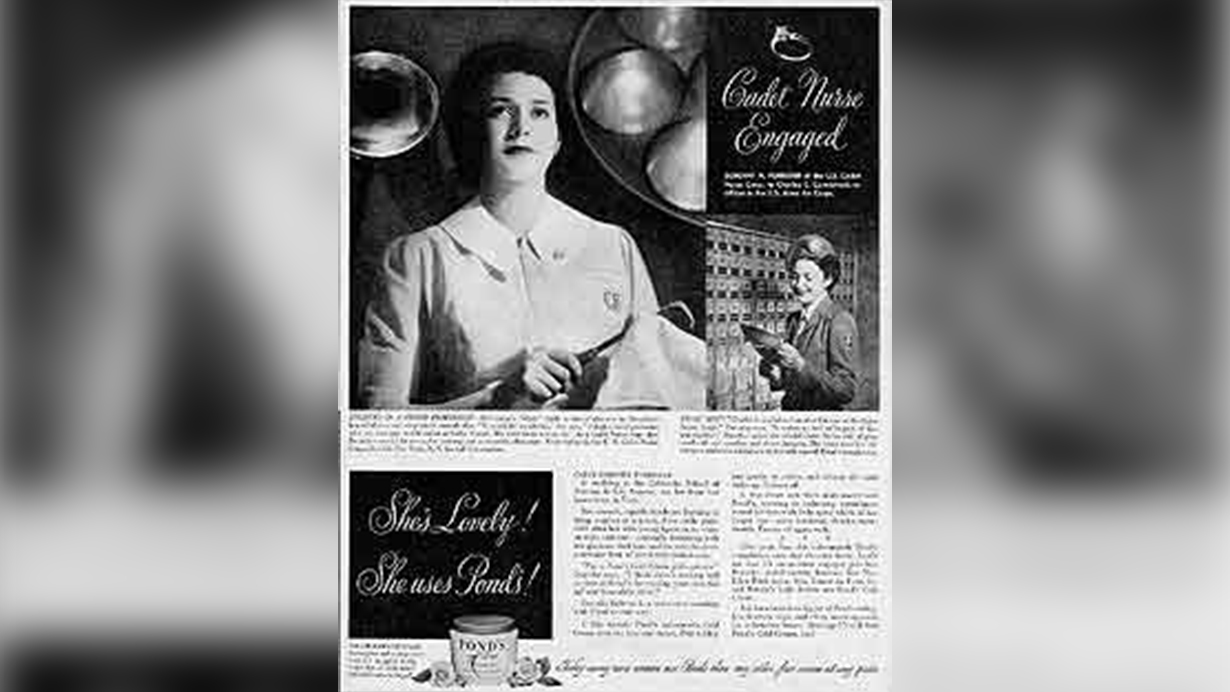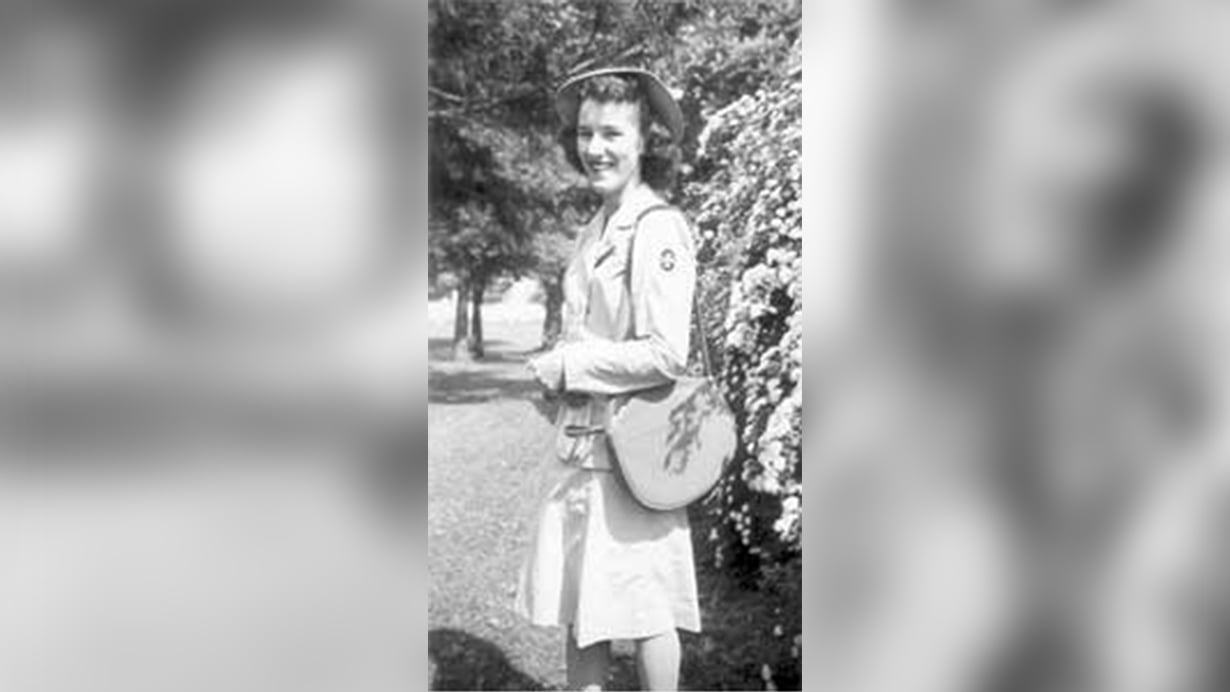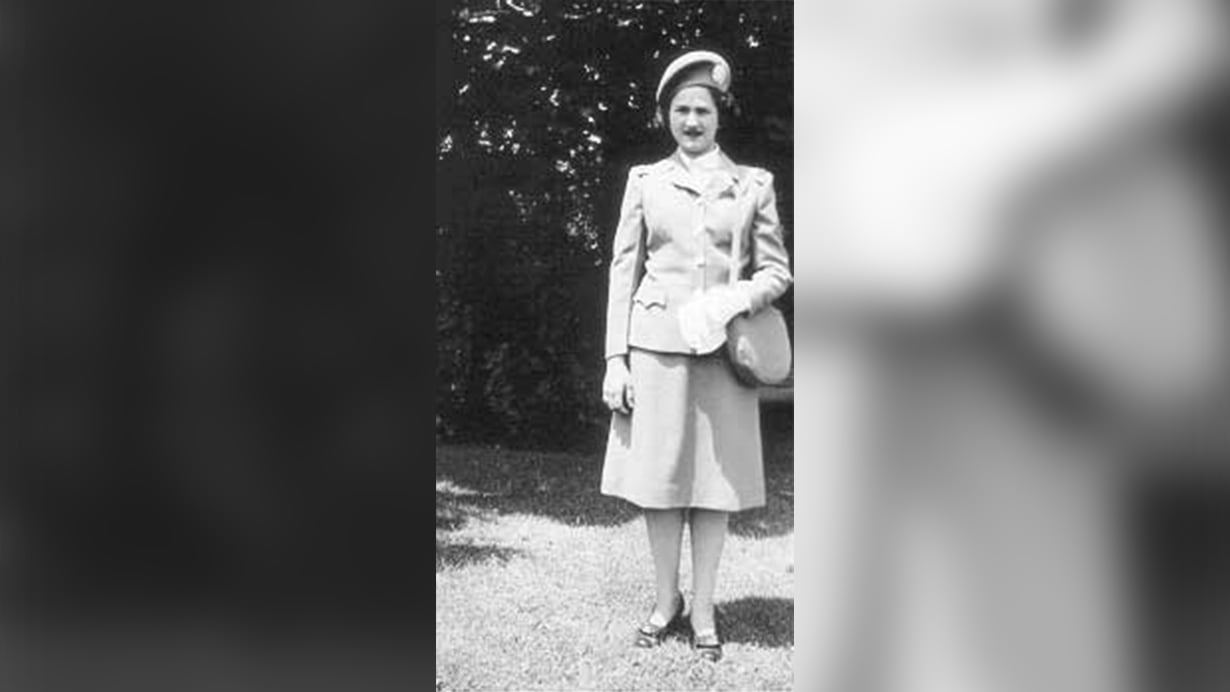Cadet Nurse Corps Train as a Nurse Recruitment Graphic
The United States Cadet Nurse Corps was a program established by the Federal government in 1943. Its primary purpose was to ensure that the United States had enough nurses to care for the needs of its citizens on both the home and war fronts. The results of the Cadet Nurse Corps included a dramatic rise in the number of nursing students, a greater public recognition of nurses, and changes in the manner in which nurses were educated and trained.
When the United States entered World War II and defense production had begun, it became clear that there was a dramatic shortage of nurses in the country. Nursing registries were established and an inventory was conducted in 1941. While there were double the nurses available than at the time of World War I, the impending war and defense industry buildup raised many questions regarding the effect of the war effort on both the military and civilian communities. These questions became more pressing as more and more doctors and nurses joined the war effort.
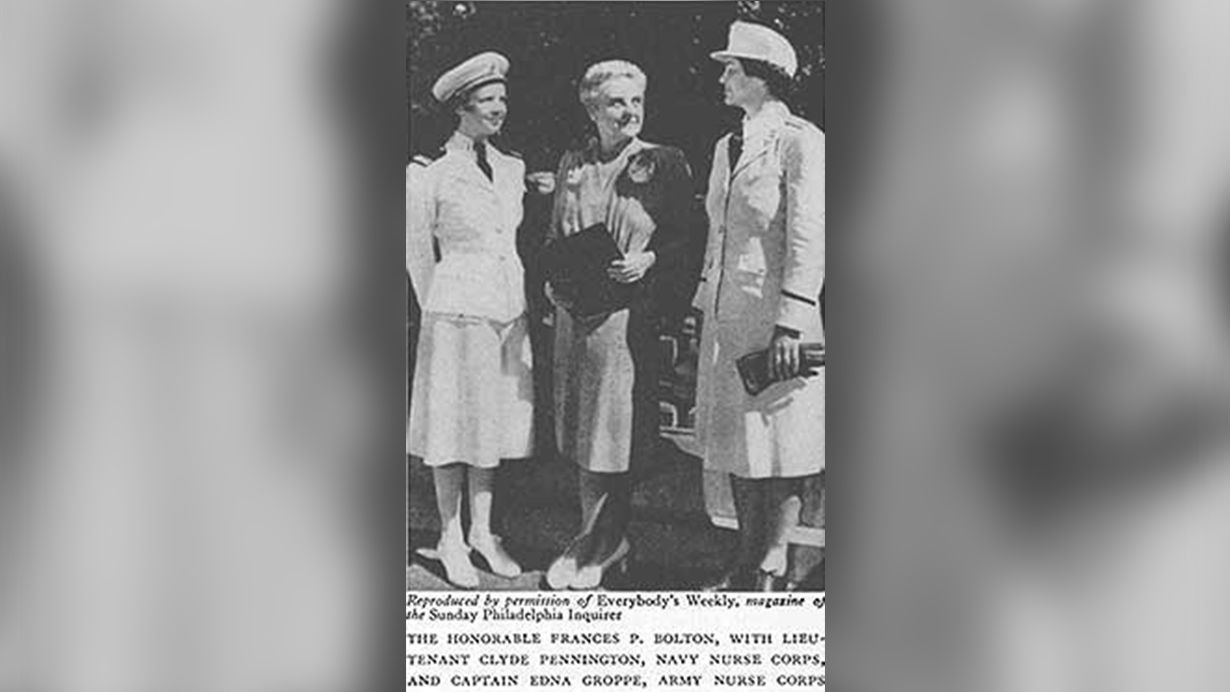
The honorable Frances P. Bolton, with Lieutenant Clyde Pennington, Navy Nurse Corps, and Caption Edna Groppe Army Nurse Coprs.
A bill was introduced by Congresswoman Frances P. Bolton (R-Ohio) on March 29, 1943, calling for the establishment of a government program to provide grants to schools of nursing to facilitate the training of nurses to serve in the armed forces, government and civilian hospitals, health agencies, and in war related industries. The Bolton Act was passed unanimously by both houses of Congress and became law on July 1, 1943.
The Division of Nurse Education was established in the United States Public Health Service to supervise the Cadet Nurse Corps and was answerable to US Surgeon General Thomas Parran. Surgeon General Parran appointed Lucille Petry, RN as the head of the Corps.
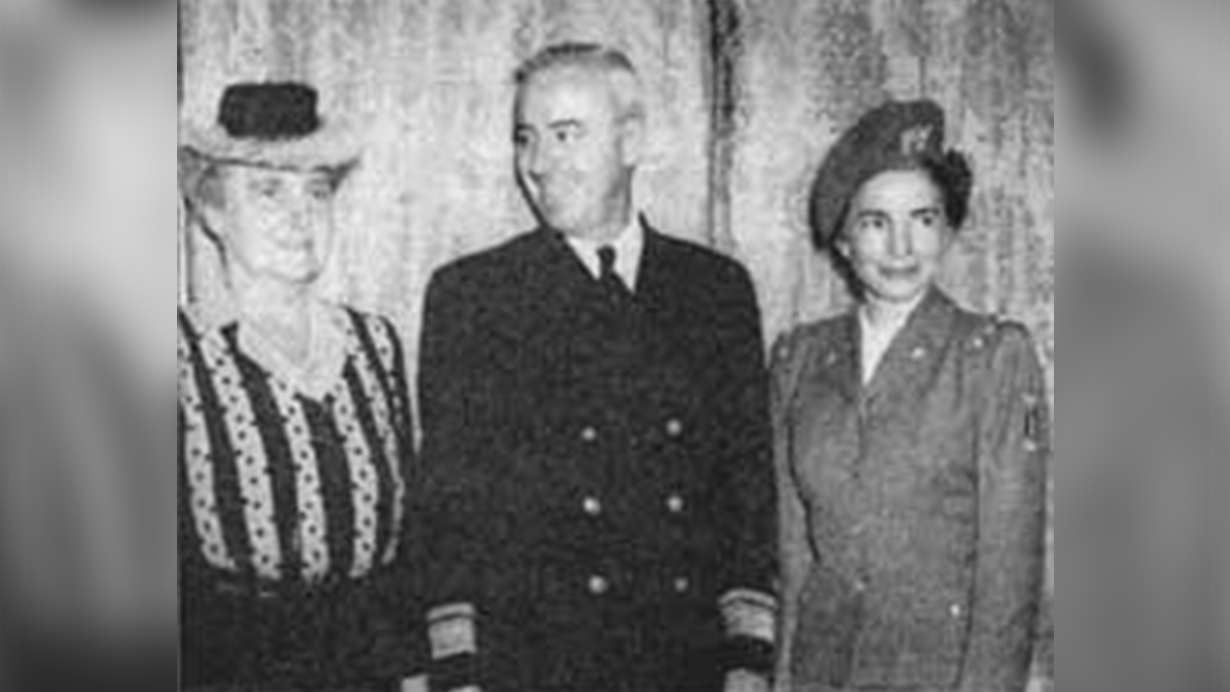
Nursing schools throughout the United States were sent telegrams announcing the formation of the Corps and were invited to join. Of the sixteen New York State schools of nursing participated in the program, six of them (The Genesee Hospital School of Nursing, Highland Hospital School of Nursing, Rochester General Hospital School of Nursing, Rochester State Hospital, St. Mary's School of Nursing, and the University of Rochester School of Nursing) in Rochester.
New York State Schools of Nursing Participating in the Cadet Nurse Corps
- Arnot-Ogden Memorial Hospital School of Nursing, Elmira
- Bellvue Hospital School of Nursing, New York
- Ellis Hospital School of Nursing, Schenectady
- Flower-Fifth Avenue Hospital School of Nursing, New York
- Genesee Hospital School of Nursing, Rochester
- Highland Hospital School of Nursing, Rochester
- Keuka College School of Nursing, Keuka Park
- Mercy Hospital School of Nursing, Buffalo
- Our Lady of Victory School of Nursing, Kingston
- Rochester General Hospital School of Nursing, Rochester
- Rochester State Hospital, Rochester
- St. Luke's Hospital School of Nursing, New York
- St. Mary's Hospital School of Nursing, Rochester
- Sisters of Charity Hospital School of Nursing, Buffalo
- State University of Plattsburg School of Nursing, Plattsburg
- University of Rochester School of Nursing, Rochester
From Cadet Nurse Stories: The Call For and Response of Women During World War II
Thelma M. Robinson and Paulie M. Perry
Rochester General Hospital Cadet Nurses
Genesee Hospital Cadet Nurses
A student nurse who joined the Cadet Nurse Corps was eligible for a government subsidy that paid for her tuition, books, and uniforms as well as a small living stipend. In return, participants in the Corps pledged to actively serve in essential civilian, military or other Federal and government services for the duration of the war.
Any young woman interested in becoming a nurse was eligible for the Cadet Nurse Corps. The only requirements a potential student had to meet were that she be between the ages of seventeen and thirty-five, be in good health, and have graduated from an accredited high school with good grades. Students were able to marry, provided that they follow the guidelines established by their school.
Cadet Nurse Pledge
At this moment of my induction into the United States Cadet Nurse Corps of the United States Public Health Service, I am solemnly aware of the obligations I assume toward my country and toward my chosen profession; I will follow faithfully the teachings of my instructors and the guidance of the physicians with whom I work; I will hold in trust the finest traditions of nursing and the spirit of the Corps; I will keep my body strong, my mind alert, and my heart steadfast; I will be kind, tolerant, and understanding; Above all, I will dedicate myself now and forever to the triumph of life over death; As a Cadet nurse, I pledge to my county my service in essential nursing for the duration of the war.
An amendment to the original Bolton Act stated that the Corps would be a non-discriminatory program - an important social aspect. Forty Native Americans, representing twenty-five tribes (in twelve states) enrolled in the Sage Hospital School of Nursing in Ganado, Arizona and 3000 African Americans joined the Cadet Nurse Corps as a result of this provision. The most visible minority students participating in the Cadet Nurse Corps were relocated Japanese-Americans. The National Japanese American Student Relocation Council was able to place students in nursing schools, many of which were participants in the Cadet Nurse Corps. Seven of these students were placed in Rochester at Rochester General's and The Genesee Hospital's Schools of Nursing.
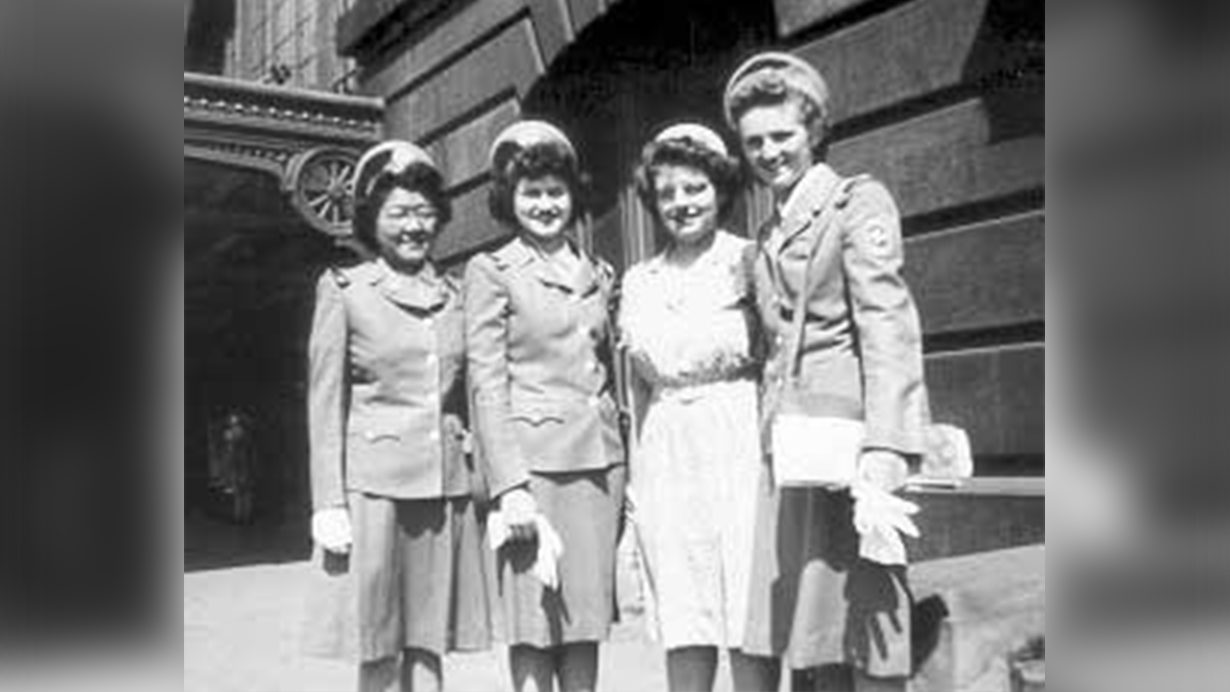
Members of the Cadet Nurse Corps were required to complete their training within thirty months instead of the traditional thirty-six months. "Pre-Cadets," traditionally known as "Probies," were in the first nine months of their training. "Junior Cadets" were in the middle twenty-one months of their schooling and "served while they learned" by attending classes and then applying their book learning in the medical, surgical, obstetric, and pediatric wards.
During the final period of training, members of the Corps were known as "Senior Cadets." These students were placed where they were most needed, many in civilian, Federal or military hospitals. Other students spent their Senior Cadet period in the Indian, Public Health or Rural Health Services. Locally, students performed their Sr. Cadet service at Rochester General or Genesee Hospitals, the Baden Street Settlement, the Rochester Health Bureau, and the Rochester Visiting Nurse Association.
Senior Cadet Assignments
| Assignment | Students | Assigned | ||
|---|---|---|---|---|
| Number | Percent | |||
|
AssignmentAssignmentAssignmentAssignmentAssignmentAssignmentAssignmentAssignmentAssignmentAssignmentAssignmentMilitary hospitals
|
StudentsStudentsStudentsStudentsStudentsStudentsStudentsStudentsStudentsStudentsStudents7,466 |
AssignedAssignedAssignedAssignedAssignedAssignedAssignedAssignedAssignedAssignedAssigned6.4 | ||
| AssignmentAssignmentAssignmentAssignmentAssignmentAssignmentAssignmentAssignmentAssignmentAssignmentAssignmentArmy | StudentsStudentsStudentsStudentsStudentsStudentsStudentsStudentsStudentsStudentsStudents6,358 | AssignedAssignedAssignedAssignedAssignedAssignedAssignedAssignedAssignedAssignedAssigned5.4 | ||
| AssignmentAssignmentAssignmentAssignmentAssignmentAssignmentAssignmentAssignmentAssignmentAssignmentAssignmentNavy | StudentsStudentsStudentsStudentsStudentsStudentsStudentsStudentsStudentsStudentsStudents1,106 | AssignedAssignedAssignedAssignedAssignedAssignedAssignedAssignedAssignedAssignedAssigned1 | ||
| AssignmentAssignmentAssignmentAssignmentAssignmentAssignmentAssignmentAssignmentAssignmentAssignmentAssignmentOther Federal hospitals | StudentsStudentsStudentsStudentsStudentsStudentsStudentsStudentsStudentsStudentsStudents10,009 | AssignedAssignedAssignedAssignedAssignedAssignedAssignedAssignedAssignedAssignedAssigned8.6 | ||
| AssignmentAssignmentAssignmentAssignmentAssignmentAssignmentAssignmentAssignmentAssignmentAssignmentAssignmentVeteran's Administration | StudentsStudentsStudentsStudentsStudentsStudentsStudentsStudentsStudentsStudentsStudents7,907 | AssignedAssignedAssignedAssignedAssignedAssignedAssignedAssignedAssignedAssignedAssigned6.8 | ||
|
AssignmentAssignmentAssignmentAssignmentAs signmentAssignmentAssignmentAssignmentAssignmentAssignmentAssignmentMarine hospitals, Public Health Service |
StudentsStudentsStudentsStudentsStudentsStudentsStudentsStudentsStudentsStudentsStudents974 | AssignedAssignedAssignedAssignedAssignedAssignedAssignedAssignedAssignedAssignedAssigned0.8 | ||
| AssignmentAssignmentAssignmentAssignmentAssignmentAssignmentAssignmentAssignmentAssignmentAssignmentAssignmentIndian service | StudentsStudentsStudentsStudentsStudentsStudentsStudentsStudentsStudents |
Chart source - The United States Cadet Nurse Corps and other Federal Nurse Training Programs
On joining the Corps, members were issued distinctive summer and winter "outside" uniforms. Summer uniforms consisted of a two piece gray and white striped cotton suit while winter uniforms were gray wool suits with a single-breasted jacket and gored skirt. Cadets were also provided with a winter overcoat of gray velour, a gray twill raincoat and a gray Montgomery beret.

Students wore their home schools' uniforms with shoulder patches indicating their status as Cadet Nurses.
An aggressive publicity and recruitment campaign was launched on behalf of the Cadet Nurse Corps. Advertisements and articles ran in popular magazines read by young women including Mademoiselle, Cosmopolitan, Colliers, Harper's Bazaar, and Ladies' Home Journal. Cadet Nurses were featured in movie newsreels and features, radio soap operas and variety shows and numerous color posters that were prominently placed in areas frequented by high school girls.
The vigorousness of this campaign was necessary to recruit the required number of nursing students, but also to convince uncertain parents that a career in nursing was worthwhile for their daughters. Many parents worried that enrollment in nursing school would prevent their daughters from marrying or lead to poor health due to great physical demands. This attitude was combated through advertisements that stressed the idea that nurses' training was good preparation for any future that a young woman might have, be it as a practicing nurse or as a homemaker.
One of the prominent advertisers that supported the Cadet Nurse Corps was the Eastman Kodak Company. In the calendar year of July 1943 to June 1944, Kodak donated one quarter of the one million plus dollars that went towards publicizing the Corps. Among Kodak's contributions was a full-page color advertisement, which ran in the New York Times on January 6, 1944.
Click here to view all Cadet Nurse Posters
Following the end of combat in the Pacific, the Federal government reviewed its wartime programs and decided that the Cadet Nurse Corps would admit no new students beginning in October 1945. Currently enrolled students were allowed to complete their training under the aegis of the program. The Cadet Nurse Corps ended in 1948 with the graduation of the last sponsored class of students.
In addition to changes in the training of nurses and a temporarily enlarged pool of nurses, a final area where the effect of the Cadet Nurse Corps may be felt is in the area of veteran affairs. The U.S. Cadet Nurse Corps Equity Act of 2003 (HR 476) was introduced by Rep. Nita Lowey and urged that participants in the Cadet Nurse Corps be granted full veteran status. This status is felt to be justified on the basis that Cadet Nurses were enlisted in a uniformed, military service in a time of war, under the command of the United States Public Health Service and the Surgeon General of the United States.
Further information on The U.S. Cadet Nurse Corps Equity Act of 2003
The United States Cadet Nurse Corps offered an innovative solution to the pressing shortage of nurses at the start of the Second World War. By offering a combination of expedited training and subsidization of nursing school tuition and associated expenses, the Federal Government developed a system that temporarily freed graduate nurses for military service while ensuring that the home-front civilian and military communities received care from well trained, competent Cadet Nurses.
Credits and Sources
Research and Text: Kathleen Emerson Britton
Layout and Web design: Susan Maples
Special Thanks To:
- Baker-Cederberg Museum and Archives would like to thank the Cadet Nurse Corps veterans who have generously shared their memories, photographs, and souvenirs of their service. Please contact the Archives if you have any memories that you would like to share.
- The U.S. Cadet Nurse Corps Equity Act of 2003
- California Emergency Nurses Association
- Frances Payne Bolton
- Sterling and Jacquelyn Emerson and Philip G. Maples for editorial comment
Sources: Information for the essay this exhibit is based upon was taken from the following sources:
- The American Journal of Nursing, August 1943 - September 1947, March 2003.
- Federal Security Agency/Public Health Service:
- The United States Cadet Nurse Corps and other Federal Nurse Training Programs 1950, United States Government Printing Office
- Beatrice J. and Philip A. Kalisch:
- "Be a Cadet Nurse: The Girl with a Future" in Nursing Outlook, Volume 21, No. 7, 1973, pages 444 – 449.
- "Slaves, Servants, or Saints? (An Analysis of the System of Nurse Training in the United States, 1873-1948)" in Nursing Forum, Volume XIV, No. 3, 1975, pages 223-263.
- Thelma M. Robinson and Paulie M. Perry:
- Cadet Nurse Stories: The Call For and Response of Women During World War II 2001, Center Nursing Press.
- Heather Willever and John Parascandola:
- "The Cadet Nurse Corps, 1943-48" in Public Health Reports: Journal of the U.S. Public Health Service, Volume 109, No. 3, May-June 1994, pages 455-457.
Students wore their home schools' uniforms with shoulder patches indicating their status as Cadet Nurses.
An aggressive publicity and recruitment campaign was launched on behalf of the Cadet Nurse Corps. Advertisements and articles ran in popular magazines read by young women including Mademoiselle, Cosmopolitan, Colliers, Harper's Bazaar, and Ladies' Home Journal. Cadet Nurses were featured in movie newsreels and features, radio soap operas and variety shows and numerous color posters that were prominently placed in areas frequented by high school girls.
The vigorousness of this campaign was necessary to recruit the required number of nursing students, but also to convince uncertain parents that a career in nursing was worthwhile for their daughters. Many parents worried that enrollment in nursing school would prevent their daughters from marrying or lead to poor health due to great physical demands. This attitude was combated through advertisements that stressed the idea that nurses' training was good preparation for any future that a young woman might have, be it as a practicing nurse or as a homemaker.
One of the prominent advertisers that supported the Cadet Nurse Corps was the Eastman Kodak Company. In the calendar year of July 1943 to June 1944, Kodak donated one quarter of the one million plus dollars that went towards publicizing the Corps. Among Kodak's contributions was a full-page color advertisement, which ran in the New York Times on January 6, 1944.
Click here to view all Cadet Nurse Posters
Following the end of combat in the Pacific, the Federal government reviewed its wartime programs and decided that the Cadet Nurse Corps would admit no new students beginning in October 1945. Currently enrolled students were allowed to complete their training under the aegis of the program. The Cadet Nurse Corps ended in 1948 with the graduation of the last sponsored class of students.
In addition to changes in the training of nurses and a temporarily enlarged pool of nurses, a final area where the effect of the Cadet Nurse Corps may be felt is in the area of veteran affairs. The U.S. Cadet Nurse Corps Equity Act of 2003 (HR 476) was introduced by Rep. Nita Lowey and urged that participants in the Cadet Nurse Corps be granted full veteran status. This status is felt to be justified on the basis that Cadet Nurses were enlisted in a uniformed, military service in a time of war, under the command of the United States Public Health Service and the Surgeon General of the United States.
Further information on The U.S. Cadet Nurse Corps Equity Act of 2003
The United States Cadet Nurse Corps offered an innovative solution to the pressing shortage of nurses at the start of the Second World War. By offering a combination of expedited training and subsidization of nursing school tuition and associated expenses, the Federal Government developed a system that temporarily freed graduate nurses for military service while ensuring that the home-front civilian and military communities received care from well trained, competent Cadet Nurses.
Credits and Sources
Research and Text: Kathleen Emerson Britton
Layout and Web design: Susan Maples
Special Thanks To:
- Baker-Cederberg Museum and Archives would like to thank the Cadet Nurse Corps veterans who have generously shared their memories, photographs, and souvenirs of their service. Please contact the Archives if you have any memories that you would like to share.
- The U.S. Cadet Nurse Corps Equity Act of 2003
- California Emergency Nurses Association
- Frances Payne Bolton
- Sterling and Jacquelyn Emerson and Philip G. Maples for editorial comment
Sources: Information for the essay this exhibit is based upon was taken from the following sources:
- The American Journal of Nursing, August 1943 - September 1947, March 2003.
- Federal Security Agency/Public Health Service:
- The United States Cadet Nurse Corps and other Federal Nurse Training Programs 1950, United States Government Printing Office
- Beatrice J. and Philip A. Kalisch:
- "Be a Cadet Nurse: The Girl with a Future" in Nursing Outlook, Volume 21, No. 7, 1973, pages 444 – 449.
- "Slaves, Servants, or Saints? (An Analysis of the System of Nurse Training in the United States, 1873-1948)" in Nursing Forum, Volume XIV, No. 3, 1975, pages 223-263.
- Thelma M. Robinson and Paulie M. Perry:
- Cadet Nurse Stories: The Call For and Response of Women During World War II 2001, Center Nursing Press.
- Heather Willever and John Parascandola:
- "The Cadet Nurse Corps, 1943-48" in Public Health Reports: Journal of the U.S. Public Health Service, Volume 109, No. 3, May-June 1994, pages 455-457.
- Laura Allen Shcherer, Class of 1945
- Olivet J. Allen, Class of 1947
- Jean C. Augustine, Class of 1945
- Margaret Austin Pangrazia, Class of 1946
- Marion Bourne Engert, Class of 1947
- Kathleen Brit Houghtaling, Class of 1947
- Betsey Buckland Sollame, Class of 1947
- Marilyn Chiyeko Iseri, Class of 1947
- Phyllis Collier King, Class of 1947
- Clara Cooper Dunsmoor, Class of 1948
- Genevieve DePauw Koch, Class of 1947
- Marion Dierna Elwell, Class of 1946
- Sybil Drake Miller, Class of 1947
- Betty Dreas Allison, Class of 1947
- Eleanor Duell Sawyer, Class of 1948
- Jean Everhart Shibley, Class of 1947
- Virginia Ferris VanDerMeid, Class of 1947
- Joyce Foster Loomis, Class of 1947
- Florence Fusaye Sato, Class of 1948
- Shirley Gray Thomson, Class of 1945
- Geraldine Haag Longbine, Class of 1945
- Reita Hutchinson DeLaVergne, Class of 1948
- Marie Joerger Swanson, Class of 1944
- Alice Kawasaki Sumida, Class of 1947
- Dorothy Lindner Hensen, Class of 1946
- Ruth A. Locke, Class of 1946
- Mary Maher O'Rourke, Class of 1947
- Elizabeth Manzler Hiemenz, Class of 1947
- Ruth Meerdink Gilmore, Class of 1947
- Ruth Mendell Hart, Class of 1945
- Misako Muira Fujii, Class of 1947
- Agnes Etsuko Ogi Yui, Class of 1947
- Geraldine T. Panzer, Class of 1947
- Lois J. Partridge, Class of 1945
- Alice Petrus Olson, Class of 1944
- June Playne Dickinson, Class of 1947
- Priscilla Preston Wilson, Class of 1946
- Pearl Schumacher Carey, Class of 1947
- Cora Stanton Massecar, Class of 1947
- Ruth Stone DeVries, Class of 1947
- Kathleen Strapp Dougherty, Class of 1944
- Sally Thompkins Wirth, Class of 1947
- Evelyn VanCuyck Proseus, Class of 1945
- Kay Wigmore Kummer, Class of 1947
- Florence Woodward DeFelice, Class of 1947
- Tomiko Yasuda, Class of 1944
- Jane Alling Felber, Class of 1946
- Ruth Amidon Robinson, Class of 1946
- Dorothy Anderson Bolesky, Class of 1946
- Rhea Archer Hagen, Class of 1946
- Norma Baumer Hoffman, Class of 1947
- Lois Becraft Rubino, Class of 1947
- Doris Bennett Caulkins, Class of 1946
- Elizabeth Berry Mulhern, Class of 1948
- Bernice Beug Scott, Class of 1946
- Evelyn Boylan Dudarchik, Class of 1947
- Jessie Broadbent Kilmer, Class of 1947
- Dorace Brooks Belknap, Class of 1946
- Mary Busse VanInwagen, Class of 1946
- Barbara Butler Moore, Class of 1946
- Jeane Callan Patsynski, Class of 1945
- Marian Campbell Dennis, Class of 1947
- Lillian Cappon Burke, Class of 1946
- Marjorie Carson Mearriam, Class of 1946
- Carmella Casaccia Houlihan, Class of 1946
- Jane Chamberlin Culver, Class of 1945
- Alberta Cheeseman Howard, Class of 1946
- Ruth Cohen Comisar, Class of 1946
- Helen Compton McLaren, Class of 1946
- A. Isabel Cooley, Class of 1946
- Catherine Cooley Driscoll, Class of 1947
- Antoinette Corona Cianca, Class of 1948
- Betty Crocker Sullivan, Class of 1948
- Arlene Dahn Davis, Class of 1948
- Evelyn DeGroot Winter, Class of 1946
- Eleanor D. Deigner, Class of 1946
- Sara DeMartino Catalano, Class of 1947
- Margaret Dennison Dundas, Class of 1947
- Sylvia Diamond Zipkin, Class of 1946
- Shirley Dick Burlee, Class of 1947
- Bernice Dodds Ward, Class of 1948
- Corinne Dorscheid Dennis, Class of 1946
- Betty Dyer Lingeman, Class of 1945
- Orpha Edmunds Easton, Class of 1947
- Jessie Eldredge Smith, Class of 1946
- Gertrude Ellsworth Seaman, Class of 1946
- Margery Elston Dubbs, Class of 1948
- Nancy Erbelding Gruendike, Class of 1946
- Josephine Ferraro Ganis, Class of 1948
- Rana Fishman Levitt, Class of 1947
- Mary Fullerton Rothwell, Class of 1945
- Margaret Gage McLaughlin, Class of 1946
- Margaret Garrett McFarland, Class of 1947
- Mary George Mayoue, Class of 1946
- Roslyn Gerring Lane, Class of 1947
- Mary Godkin Mack, Class of 1946
- Elinor Goldsworthy Melech, Class of 1947
- Mary Gray Woodruff, Class of 1947
- Julia Gregory Barry, Class of 1947
- Mary Hall Carter, Class of 1947
- June Hall Aubel, Class of 1947
- Phyllis Hall Morena, Class of 1948
- Helen Hayden Sullivan, Class of 1946
- Marcia Hinz Hill, Class of 1947
- Elaine Hoffman Bean, Class of 1947
- Edith Horning Kestler, Class of 1946
- Arleen House Quetschenbach, Class of 1945
- Carlotta J. Garufo, Class of 1948
- Mary E. Johnson, Class of 1947
- Sara Johnson Tolan, Class of 1947
- Alice M. Judd, Class of 1945
- Sarah Kenney Howe, Class of 1947
- Jean Kierst Eshenour, Class of 1947
- Joyce Klippel Ashley, Class of 1947
- Mildred Kreag Gertzog, Class of 1946
- Beverly Lannon Hobbs, Class of 1947
- Norma Lay Smith, Class of 1946
- Dorothy Lee Sullivan, Class of 1947
- Ruth L. Lewis, Class of 1946
- Betty Litchard Leeman, Class of 1948
- Martha Lynch Halbert, Class of 1946
- Jessie Lyvers Anders, Class of 1947
- Doris MacDonald Jones, Class of 1948
- Johanna Mariani Pugliese, Class of 1948
- Marie Mayo Weider, Class of 1947
- Dorothy Meng Gradel, Class of 1946
- Carolyn L. Miller, Class of 1946
- Marian Miller Talkenberg, Class of 1948
- Rosemary Moriarty Smith, Class of 1946
- Marion Murphy Grove, Class of 1948
- Josephine L. Pedulla, Class of 1946
- Elizabeth Powderly Unger Messecor, Class of 1945
- Margaret Radner Burkhart, Class of 1945
- Virginia Redder Smith, Class of 1945
- Gladys Reid Lusk, Class of 1947
- Lauretta Rigby Kostecke, Class of 1946
- Anna Rink Marmo, Class of 1947
- Doris Rockcastle Blakely, Class of 1945
- Mary Rose Lake, Class of 1945
- Mildred Rowland Kirkland, Class of 1948
- Betty Ruch Lindemuth, Class of 1946
- Marguerite Saulsbury Bashaw, Class of 1948
- Ruth-Marie Schaedlich Rosser, Class of 1946
- Morjorie Schlosburg Winograd, Class of 1947
- Elizabeth Schram Finewood, Class of 1947
- Althea Schweitzer Bigham, Class of 1945
- Jane Seymour Gleam, Class of 1946
- Assunta Simotti Nazzaro, Class of 1947
- Marion Smalt Fromen, Class of 1947
- Ruth Spencer Gartland, Class of 1946
- C. Mary Stefani Brown, Class of 1947
- Tessie Stern Tuniman, Class of 1946
- Marilyn Stockham Zobel, Class of 1947
- Marion Swan Garnish, Class of 1948
- Hazel Sweeney Mitchell, Class of 1946
- Elizabeth Symonds Shelton, Class of 1946
- Inez T. Ranalletta, Class of 1948
- Lucille Taylor Kinsella, Class of 1948
- Patty Tennent Tyler, Class of 1947
- Betty Tillotson Beers, Class of 1946
- Sally Tompkins Carver, Class of 1947
- Madeline C. Tuori, Class of 1947
- Jacqueline VanArtsdalen Roessner, Class of 1946
- June Walker Paisley, Class of 1947
- Roberta Washburn Campbell, Class of 1948
- Marjorie Wilbur Weiss, Class of 1945
- Mariam Wilkinson Dubec, Class of 1947
- Rose Williams Lynch, Class of 1947
- Ruth Winter Lubanski, Class of 1946
- Caroline Wittman Strub, Class of 1945
- Fumi Yasaki Yamasaki, Class of 1946
- Helen Yaworski Chilkotowsky, Class of 1948
- Frances Yuge Kirihara, Class of 1946
- Veneranda Zarola Hannon, Class of 1948
- Doris Zarpentine Foster, Class of 1946

